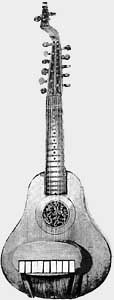|
Organology: Harp Guitar "Relatives" Note to the casual reader or researcher: This Reference Gallery features historical instruments that are not harp guitars, but “relatives” or distant “cousins” – presented on Harpguitars.net for historical and organological comparison.
Arch-citterns I separate this group into what I call "true" arch-citterns and "false" arch-citterns. The instruments of the first group are theorboed versions of historically traditional "true" citterns. The second (and most common) group consists of superficially similar instruments, descended from guittars (aka "English guitars")(ergo "false" citterns). Stringing and tuning are the main factors that separate the two general groups. See bottom of page for image copyright information |
"True"
 |
 |
 |
 |
 |
| W.
Tieffenbrucker, Padua, c. 1590
The so-called |
Thomas Robinson, 1609 | Andreas E. Kram, Nuremberg, 1768 | Kram, 1785 | Johann G. Klemm, Radeberg, 1755 |
"False" (arch-cistre, arch-guittar, etc.)
 |
 |
 |
 |
 |
 |
 |
| French, c.1780 | French, c.1780 | Renault, Paris, late 18th century | Renault & Chatekain, Paris, 1787 |
Liesem, 1757 |
G. Deleplanque, Lille, 1792 | The German "waldzither" (they consider it a "necked" zither) is a cittern variant. Usually with 9 strings, some have more, and some have the lower single basses off the neck like this one. |
For more information on the cittern, visit the wonderful Renovata
Cythara site.
For more information on the guittar and its relatives, see P. Poulopoulos: The
Guittar in the British Isles, 1750-1810
|
|
|
All Site Contents Copyright © Gregg Miner, 2004,2005,2006,2007,2008,2009,2010,2011,2012. All Rights Reserved. Copyright and Fair Use of material and use of images: See Copyright and Fair Use policy. |